Brueghel, Taxes, and the Numeration of the People of Bethlehem (1566)
 |
|
Pieter Brueghel the Elder (1525-1569)
|
Pieter Brueghel the Elder (1525-1569) was a Flemish painter famous for his landscapes and depictions of peasant life. In this painting, "The Numeration (Census) of the People of Bethlehem" (1566), he takes Luke's account of the birth of Jesus in the town of Bethlehem and transposes it to mid-16th century Netherlands. In the Gospel of Luke (2: 1-7) it is stated that the reason Jesus was born in Bethlehem was because his parents were ordered by Emperor Augustus to return to their ancestral village at a time when Mary was pregnant, thus linking the founding story of the Christian religion with Roman imperial economic policy:
1 And it came to pass in those days, that there went out a decree from Cæsar Augustus, that all the world should be taxed.
2 (And this taxing was first made when Cyrenius was governor of Syria.)
3 And all went to be taxed, every one into his own city.
4 And Joseph also went up from Galilee, out of the city of Nazareth, into Judæa, unto the city of David, which is called Bethlehem; (because he was of the house and lineage of David)
5 To be taxed with Mary his espoused wife, being great with child.
[See an OLL "Quotations about Liberty and Power" for more details].
The Reformation had taken root in the Netherlands which at that time was ruled by Catholic Spain under the Bourbon monarch Philip II. In addition to religious turmoil and persecution, the Flemish people suffered under heavy taxation imposed by Philip II in order to fight wars against the Ottoman Turks for control of the Mediterranean. In this context it is not surprising that Brueghel would find the biblical story of Joseph and Mary, forced by the Roman Emperor Caesar Augustus to return to their ancestral city in order to be taxed, rather compelling. The Dutch Revolt against Spanish imperial control broke out in 1568 shortly after the work was painted.
In addition to religious paintings, Brueghel was fascinated with the everyday life of the Flemish peasants which he saw around him and thus painted a series of very detailed pictures which chronicle various aspects of their everyday life. From his paintings historians can learn a great deal about contemporary clothing, everyday economic activity, and popular culture (such as festivals and weddings). Some of his better known works in this genre include:
- Netherlandish Proverbs (1559) [800 px]
- Children's Games (1560) [800 px]
- The Peasant Wedding (1568) [800 px]
- The Harvesters (1565) [800 px]
- The Peasant Dance (1568) [800 px]
- The Wedding Dance (c.1566) [800 px]
Pieter Brueghel the Elder, "The Numeration (Census) of the People of Bethlehem" (1566)
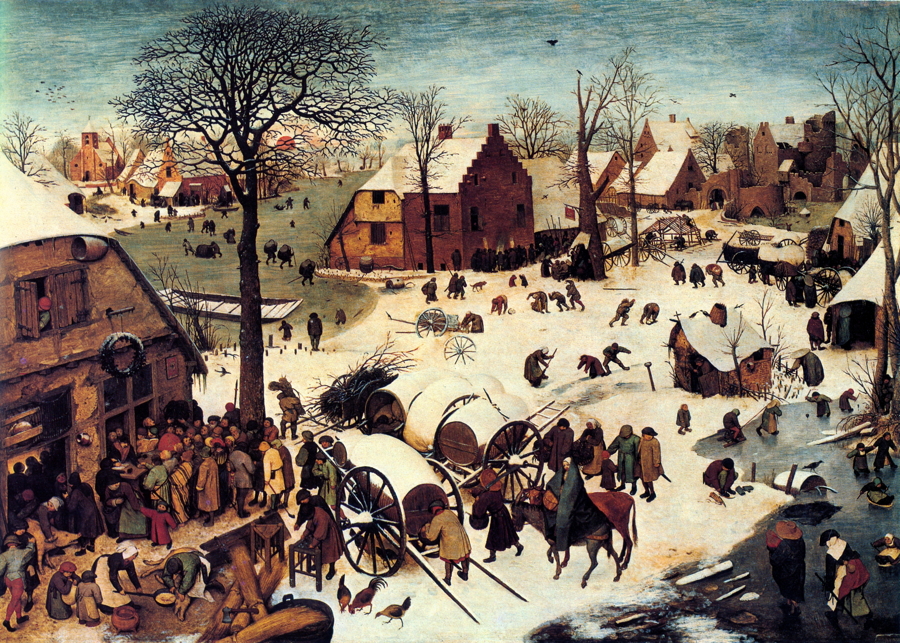 |
|
Pieter Brueghel the Elder, "The Numeration (Census) of the People of Bethlehem" (1566)
[See a larger version of this image 6.5 MB JPG 2439 px] |
Description
The painting is divided into two major components: the foreground and the background. In the foreground we see from left to right women working with food preparation at the inn; immediately behind them we see a cluster of ordinary people lined up to have their names checked off a ledger and then forced to hand over their taxes to an imperial official, in the center there is a couple who seem to be Joseph and Mary on a donkey moving towards the tax collectors; at the right there are numerous adults engaged in economic activities and children playing on a frozen pond. The rest of the painting is taken up with scenes of ordinary people at work and play in the middle of winter. In the center background there is a second group of people who have gathered outside the other large building on the village square. It is not clear what they are doing, but there appears to be a squad of soldiers nearby perhpas ensuring order in the village while the taxes are collected. The following images show more detailed snapshots of parts of the foreground of the painting:
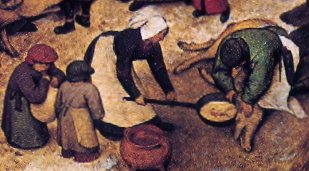 |
|
Left foreground: women preparing food in front of the inn.
|
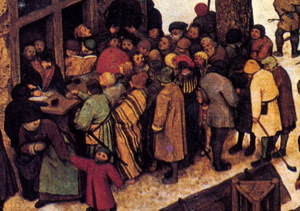 |
|
Left foreground: people gathered around a table to get their names ticked off an official ledger by two imperial officials, and then paying their taxes to a man who enters the details into another ledger.
|
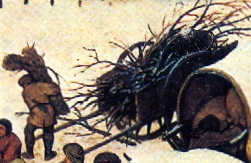 |
|
Left foreground: a man is working with faggots of firewood (he is either loading or unloading a cart. Directly below him at the very front of the picture is an axe and other bundles of firewood which he has been trimming).
|
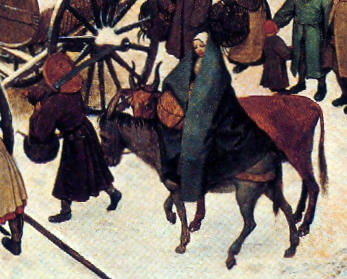 |
|
Center foreground: a man is leading a donkey on which sits a woman who is draped in a blanket (this is meant to be Joseph and Mary from Luke's Gospel account).
|
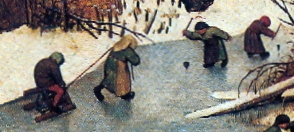 |
|
Right foreground: children playing on a frozen pond (two spinning tops and two playing with a sled)
|
In the central background of the picture is another group of people whose activities are hard to determine. They are gathered in front of the other large building around the square. A woman with a head scarfe seems to be showing something (perhaps papers) to a man. Other people are clustered around what appears to be a source of light (perhaps a fire) or another table. To the right is a group of people who appear to be holding spears. This could be a squad of soldiers who have been sent to keep order in the village as the taxes are collected. Another possiblility is that they have been sent to find more conscripts for the imperial army.
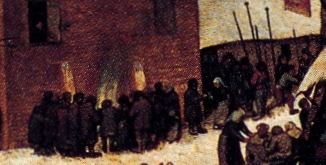 |
|
Center background: a second group in the village square (with soldiers?)
|
Source
This image is in the public domain as is widely available.
Online Resources